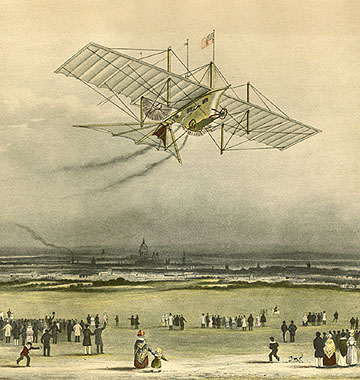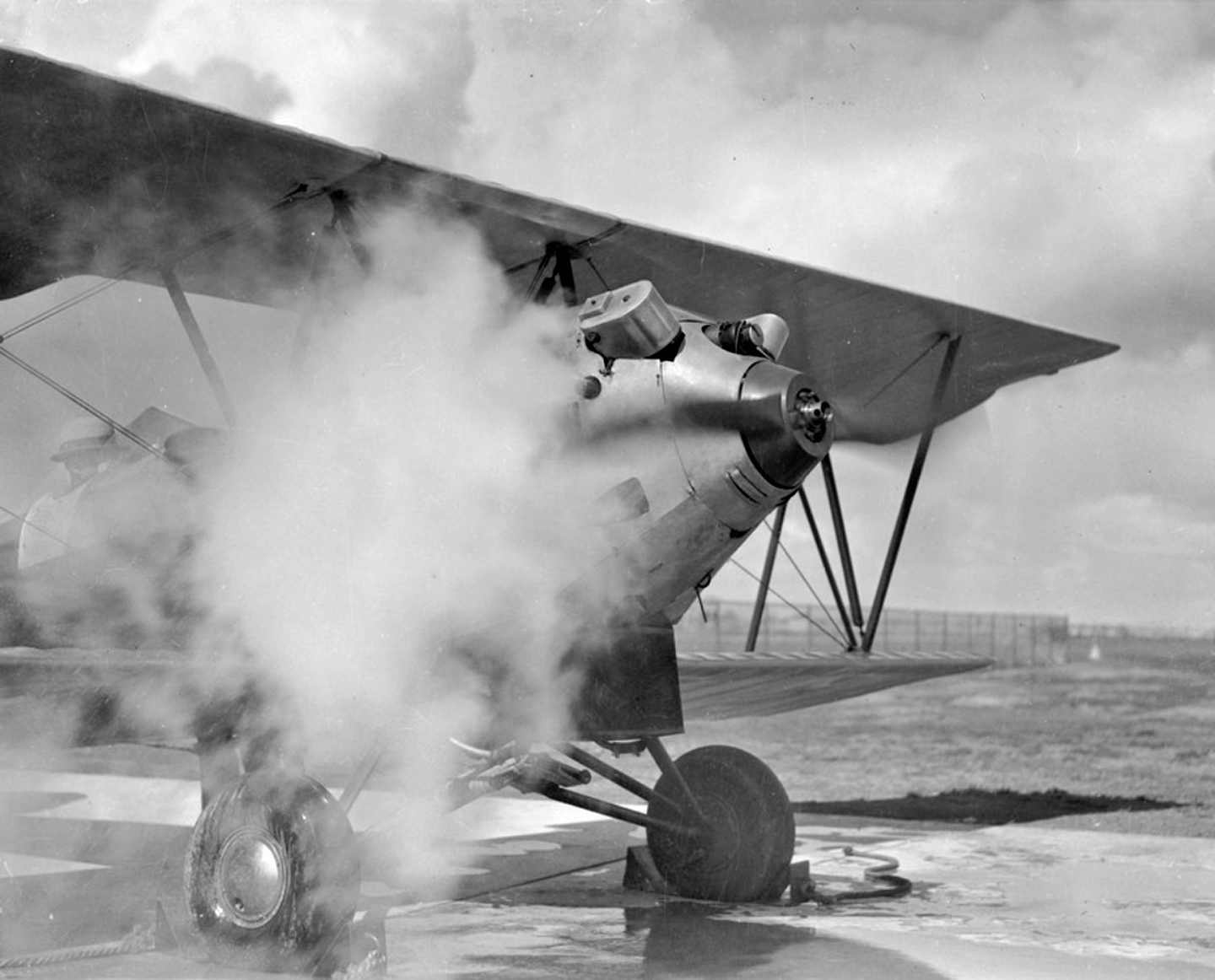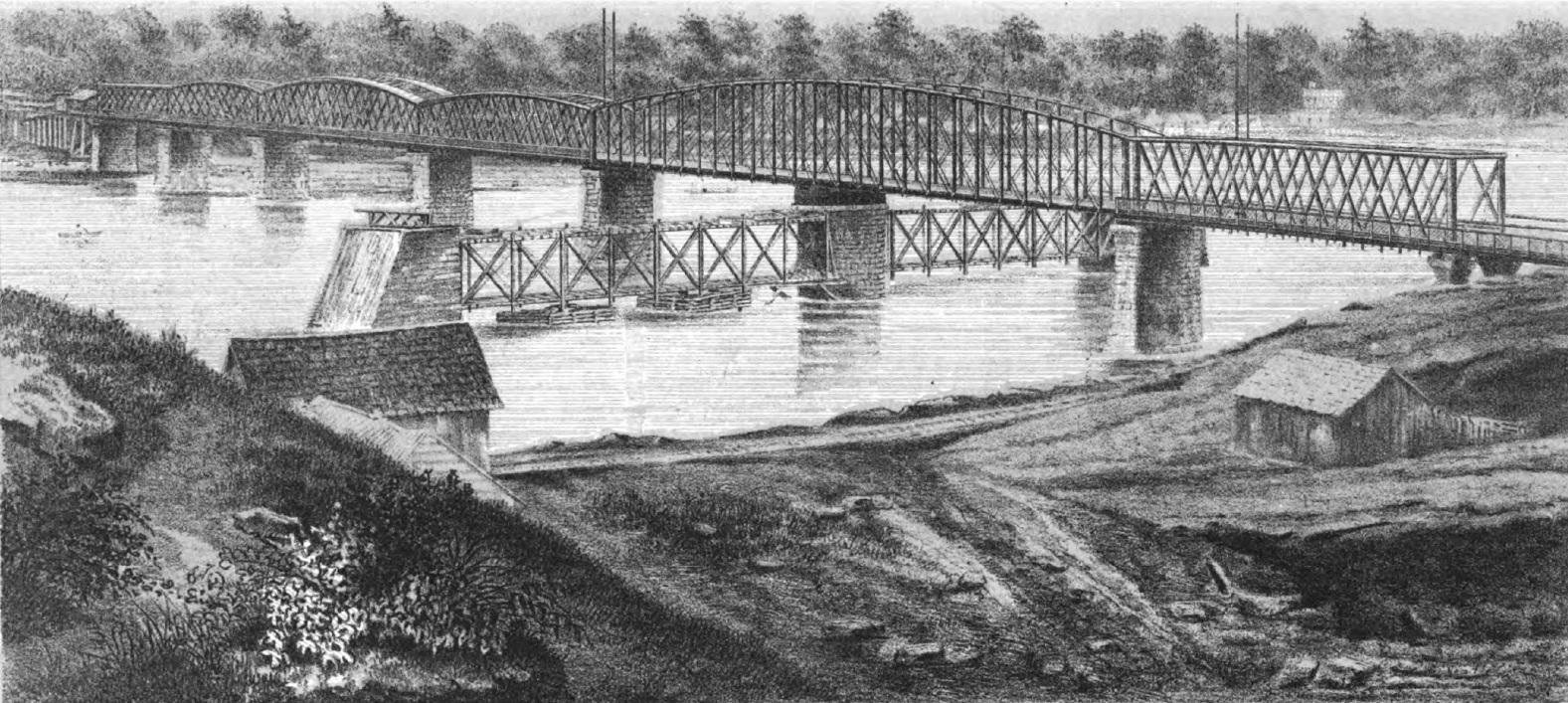|
Monoplane (1874)
The du Temple Monoplane was a steam-powered aircraft made of aluminium, built in Brest, France, by naval officer Félix du Temple in 1874. It had a wingspan of 13 m (43 ft) and weighed 80 kg (180 lb) without the pilot. Several trials were made with the aircraft, and it is generally recognized that it achieved lift-off. It was described by Dollfus as a "short hop or leap"; ''Flight International'' described the plane as having "staggered briefly into the air" – (from a combination of its own power and running down an inclined ramp) It glided for a short time and returned safely to the ground, making it the first successful powered flight in history, though not the first self-powered one. It was displayed at the 1878 ''Exposition Universelle'' ("World Fair") in Paris. Steam engine The aircraft used a very compact, high-speed circulation steam engine for which Félix du Temple applied for a patent on 28 April 1876. The engine used very small pipes packed ... [...More Info...] [...Related Items...] OR: [Wikipedia] [Google] [Baidu] |
Steam Aircraft
A steam-powered aircraft is an aircraft propelled by a steam engine. Steam power was used during the 19th century, but fell into disuse with the arrival of the more practical internal combustion engine at the beginning of the pioneer era. Steam power is distinct from its use as a lifting gas in thermal airships and early balloons. History * 1842: The Aerial Steam Carriage of William Samuel Henson and John Stringfellow was patented, but was never successful, although a steam-powered model was flown in 1848. * 1852: Henri Giffard flew a 3-horsepower (2 kW) steam-powered dirigible over Paris; it was the first powered aircraft. * 1861 Gustave Ponton d'Amécourt made a small steam-powered craft, coining the name helicopter. * 1874: Félix du Temple flew a steam-powered aluminium monoplane off a downhill run. While it did not achieve level flight, it was the first manned heavier-than-air powered flight. * 1877: Enrico Forlanini built and flew a model steam-powered heli ... [...More Info...] [...Related Items...] OR: [Wikipedia] [Google] [Baidu] |
Flash Boiler
A flash boiler is a type of water-tube boiler. The tubes are close together and water is pumped through them. A flash boiler differs from the type of monotube steam generator in which the tube is permanently filled with water. In a flash boiler, the tube is kept so hot that the water feed is quickly flashed into steam and superheated. Flash boilers had some use in automobiles in the 19th century and this use continued into the early 20th century. History There is disagreement about the exact definition of a flash boiler. Some writers use the term interchangeably with monotube boiler and there is even use of the term ''semi-flash boiler''. However, the flash boiler is generally attributed to Léon Serpollet who used a flash boiler in the Gardner-Serpollet steam-powered car from 1896. Serpollet's boiler was a low-water-content type with thick-walled tubes to provide a store of heat. Serpollet patented a steam generator in 1888, US Patent 379,421, but this is an early version whic ... [...More Info...] [...Related Items...] OR: [Wikipedia] [Google] [Baidu] |
Steam-powered Aircraft
A steam-powered aircraft is an aircraft propelled by a steam engine. Steam power was used during the 19th century, but fell into disuse with the arrival of the more practical internal combustion engine at the beginning of the pioneer era. Steam power is distinct from its use as a lifting gas in thermal airships and early Balloon (aeronautics), balloons. History * 1842: The Aerial Steam Carriage of William Samuel Henson and John Stringfellow was patented, but was never successful, although a steam-powered model was flown in 1848. * 1852: Henri Giffard flew a 3-horsepower (2 kW) steam-powered airship, dirigible over Paris; it was the first powered aircraft. * 1861 Gustave Ponton d'Amécourt made a small steam-powered craft, coining the name helicopter. * 1874: Félix du Temple de la Croix, Félix du Temple flew a steam-powered aluminium Du Temple Monoplane, monoplane off a downhill run. While it did not achieve level flight, it was the first manned heavier-than-air powered ... [...More Info...] [...Related Items...] OR: [Wikipedia] [Google] [Baidu] |
19th-century French Experimental Aircraft
The 19th century began on 1 January 1801 (represented by the Roman numerals MDCCCI), and ended on 31 December 1900 (MCM). It was the 9th century of the 2nd millennium. It was characterized by vast social upheaval. Slavery was abolished in much of Europe and the Americas. The First Industrial Revolution, though it began in the late 18th century, expanded beyond its British homeland for the first time during the 19th century, particularly remaking the economies and societies of the Low Countries, France, the Rhineland, Northern Italy, and the Northeastern United States. A few decades later, the Second Industrial Revolution led to ever more massive urbanization and much higher levels of productivity, profit, and prosperity, a pattern that continued into the 20th century. The Catholic Church, in response to the growing influence and power of modernism, secularism and materialism, formed the First Vatican Council in the late 19th century to deal with such problems and confirm ce ... [...More Info...] [...Related Items...] OR: [Wikipedia] [Google] [Baidu] |
Timeline Of Aviation In The 19th Century
This is a list of aviation-related events during the 19th century (1 January 1801 – 31 December 1900): 1800–1859 * 1802 ** 5 July – André-Jacques Garnerin and Edward Hawke Locker make a balloon flight from Lord's Cricket Ground in St John's Wood to Chingford in just over 15 minutes. ** 2 December – A manned illuminated balloon is launched from the front of Notre Dame de Paris during the Coronation of Napoleon I. * 1803 ** British Rear Admiral Charles Knowles proposes to the Admiralty that the Royal Navy loft an observation balloon from a ship in order to reconnoitre French preparations for the invasion of Britain in Brest. The proposal is ignored.Layman 1989, p. 31. ** 18 July – Etienne Gaspar Robertson and his copilot Lhoest ascend from Hamburg, Germany, to an altitude of around in a balloon. ** 3–4 October – André-Jacques Garnerin covers a distance of from Paris to Clausen, Germany. ** 7–8 October – Francesco Zambecc ... [...More Info...] [...Related Items...] OR: [Wikipedia] [Google] [Baidu] |
History Of Aviation
The history of aviation spans over two millennia, from the earliest innovations like kites and attempts at tower jumping to Supersonic speed, supersonic and hypersonic flight in powered, heavier-than-air flight, heavier-than-air jet aircraft. Kite flying in China, dating back several hundred years BC, is considered the earliest example of man-made flight. In the 15th-century Leonardo da Vinci created several flying machine designs incorporating aeronautical concepts, but they were unworkable due to the limitations of contemporary knowledge. In the late 18th century, the Montgolfier brothers invented the Hot air balloon, hot-air balloon which soon led to manned flights. At almost the same time, the discovery of hydrogen gas led to the invention of the hydrogen balloon. Various theories in mechanics by physicists during the same period, such as fluid dynamics and Newton's laws of motion, led to the development of modern aerodynamics; most notably by Sir George Cayley. Balloons, ... [...More Info...] [...Related Items...] OR: [Wikipedia] [Google] [Baidu] |
Early Flying Machines
Early may refer to: Places in the United States * Early, Iowa, a city * Early, Texas, a city * Early Branch, a stream in Missouri * Early County, Georgia * Fort Early, Georgia, an early 19th century fort Music * Early B, stage name of Jamaican dancehall and reggae deejay Earlando Arrington Neil (1957–1994) * Early James, stage name of American singer-songwriter Fredrick Mullis Jr. (born 1993) * Early (Scritti Politti album), ''Early'' (Scritti Politti album), 2005 * Early (A Certain Ratio album), ''Early'' (A Certain Ratio album), 2002 * Early Records, a record label Other uses * Early (name), a list of people and fictional characters with the given name or surname * Early effect, an effect in transistor physics * Early, a synonym for ''hotter'' in Stellar classification#"Early" and "late" nomenclature, stellar classification See also * * The Earlies, a 21st century band * Earley (other) * Earlie, a given name {{disambiguation, geo ... [...More Info...] [...Related Items...] OR: [Wikipedia] [Google] [Baidu] |
Torpedo Boat
A torpedo boat is a relatively small and fast naval ship designed to carry torpedoes into battle. The first designs were steam-powered craft dedicated to ramming enemy ships with explosive spar torpedoes. Later evolutions launched variants of self-propelled Whitehead torpedoes. These were inshore craft created to counter both the threat of battleships and other slow and heavily armed ships by using speed, agility, and powerful torpedoes, and the overwhelming expense of building a like number of capital ships to counter an enemy. A swarm of expendable torpedo boats attacking en masse could overwhelm a larger ship's ability to fight them off using its large but cumbersome guns. A fleet of torpedo boats could pose a similar threat to an adversary's capital ships, albeit only in the coastal areas to which their small size and limited fuel load restricted them. The introduction of fast torpedo boats in the late 19th century was a serious concern to the era's naval strategists, i ... [...More Info...] [...Related Items...] OR: [Wikipedia] [Google] [Baidu] |
French Navy
The French Navy (, , ), informally (, ), is the Navy, maritime arm of the French Armed Forces and one of the four military service branches of History of France, France. It is among the largest and most powerful List of navies, naval forces in the world recognised as being a blue-water navy. The French Navy is capable of operating globally and conducting expeditionary missions, maintaining a significant Standing French Navy Deployments, overseas presence. The French Navy is one of eight naval forces currently operating Fixed-wing aircraft, fixed-wing aircraft carriers,Along with the United States Navy, U.S., Royal Navy, U.K., People's Liberation Army Navy, China, Russian Navy, Russia, Italian Navy, Italy, Indian Navy, India, and Spanish Navy, Spain with its flagship being the only Nuclear marine propulsion, nuclear-powered aircraft carrier outside the United States Navy, and one of two non-American vessels to use Aircraft catapult, catapults to launch aircraft. Founded in the ... [...More Info...] [...Related Items...] OR: [Wikipedia] [Google] [Baidu] |
Octave Chanute
Octave Chanute (February 18, 1832 – November 23, 1910) was a French-American civil engineer and aviation pioneer. He advised and publicized many aviation enthusiasts, including the Wright brothers. At his death, he was hailed as the father of aviation and the initial concepts of the heavier-than-air flying machine. Early life Octave Chanute was born in Paris to Elise and Joseph Chanut, professor at the Collège de France. Octave and Joseph emigrated to the United States of America in 1838, when Joseph was named Vice President of Jefferson College in Louisiana. Octave attended private schools in New York. He added the "e" to his last name in his adult life. In 1857, he married Anne Riddell James, with whom he had a son and three daughters. Career Railroad civil engineer Chanute began his training as a civil engineer in 1848. He was widely considered brilliant and innovative in the engineering profession. He designed and constructed the two biggest stockyards in the United Sta ... [...More Info...] [...Related Items...] OR: [Wikipedia] [Google] [Baidu] |







